Key takeaways
- Chocolate tempering stabilizes crystals, giving chocolate a glossy finish and satisfying snap.
- Key tools for tempering include a digital thermometer, heatproof bowl, and sturdy spatula.
- Common mistakes include overheating chocolate, rushing the cooling process, and not using proper temperature measurement.
- Properly tempered chocolate enhances desserts by improving appearance, texture, and flavor release.
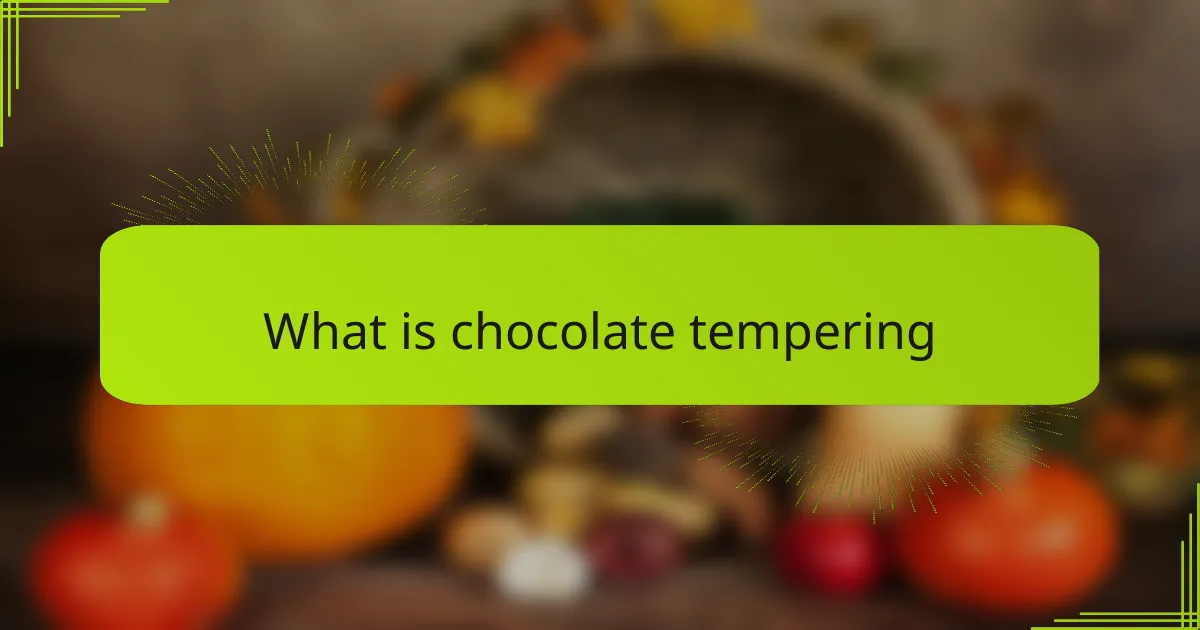
What is chocolate tempering
Chocolate tempering is the art of carefully melting and cooling chocolate to stabilize its crystals. I used to wonder why my homemade chocolate often looked dull or felt soft, until I learned that tempering gives it that perfect glossy finish and satisfying snap. Have you ever bitten into a chocolate bar and noticed how it shatters just right? That texture comes from properly tempered chocolate.
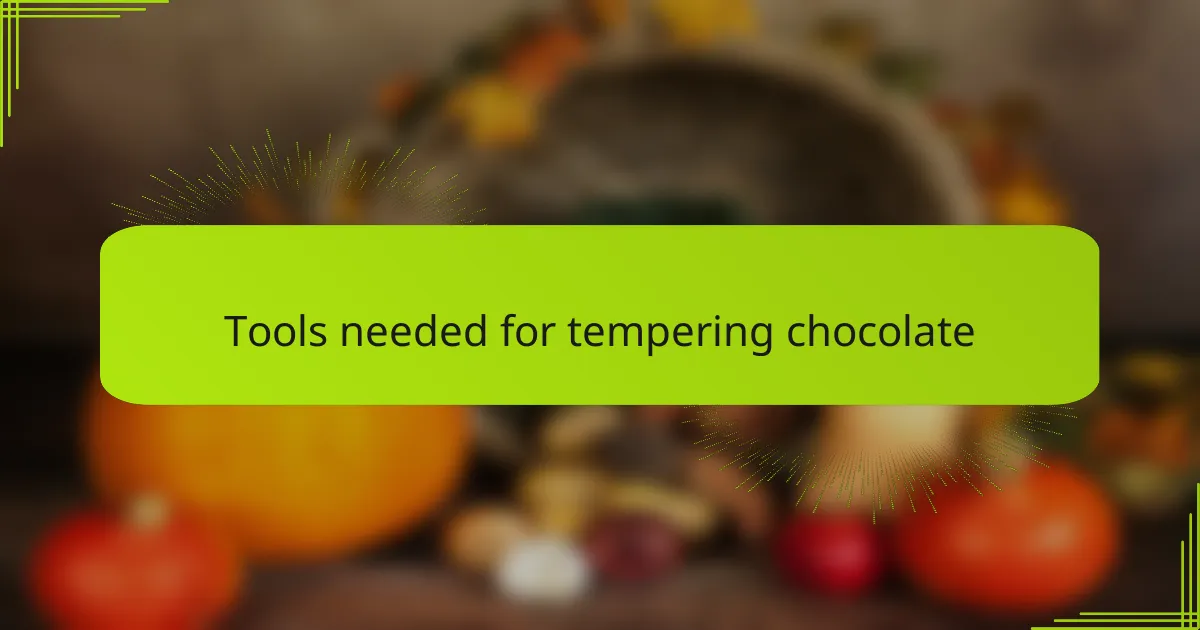
Tools needed for tempering chocolate
When I first started tempering chocolate, I quickly realized that having the right tools made all the difference. A good-quality digital thermometer became my best friend—it’s essential for hitting those precise temperature points that make tempering work. Without it, I would have been guessing and likely ending up with grainy or dull chocolate every time.
Another tool I found indispensable is a heatproof bowl, preferably stainless steel or glass. I learned the hard way that some materials retain heat too much or unevenly, which can mess with the chocolate’s temperature. Using the right bowl helped me control the melting process more reliably.
And let’s not forget a sturdy spatula. It might sound simple, but scraping and stirring chocolate smoothly prevents clumps and helps distribute heat evenly. Trust me, using a flimsy tool only adds frustration to an already delicate process. Have you tried tempering chocolate without these basics? It’s like trying to paint without brushes!
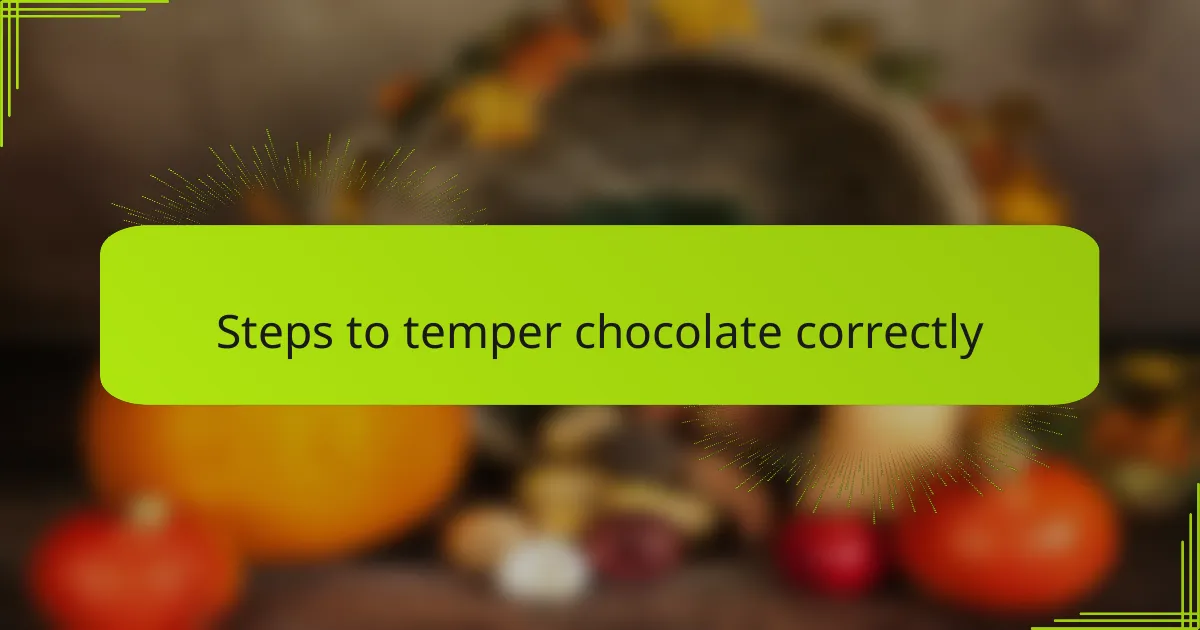
Steps to temper chocolate correctly
The first step I learned was to chop the chocolate into small, even pieces. I used to dump big chunks into the bowl and wonder why some parts melted while others stubbornly stayed solid. Breaking the chocolate down ensured it melted smoothly and consistently, making the whole process less stressful.
Next, heating the chocolate gently and watching the temperature was crucial. I remember anxiously hovering over the stove, thermometer in hand, trying to keep the chocolate from overheating. Melting it to about 45°C (113°F) felt like walking a tightrope—too hot, and the chocolate would burn; too cool, and it wouldn’t melt right.
Finally, the cooling and reheating steps were where tempering truly came alive for me. Seeding the melted chocolate with unmelted pieces and stirring until it reached about 31°C (88°F) tested my patience, but it was worth it when the chocolate set beautifully with that glossy shine and perfect snap. Have you ever experienced that moment when your tempering finally clicks? It’s oddly satisfying, like solving a tasty puzzle.
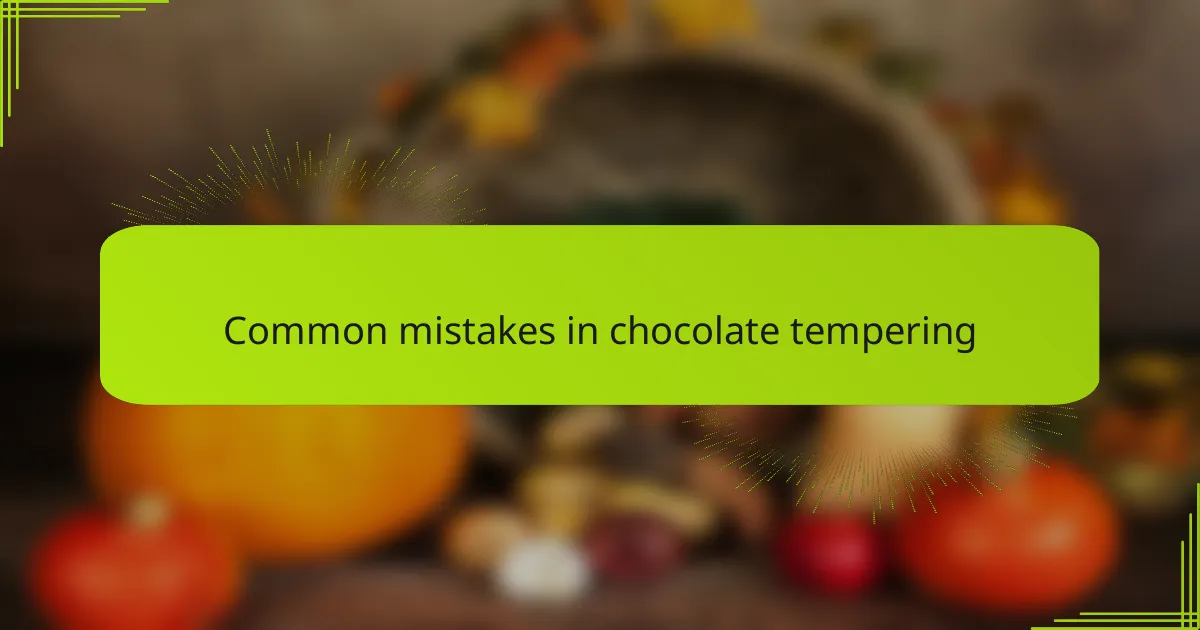
Common mistakes in chocolate tempering
One of the biggest mistakes I made early on was overheating the chocolate. I thought a little extra heat would speed things up, but it just ruined the texture—my chocolate turned grainy and dull. Have you ever felt that frustration of watching your glossy hopes melt into a sticky mess? It’s tough, but keeping a close eye on the temperature is key.
Another slip-up I encountered was rushing the cooling step. I used to skip stirring or cool the chocolate too quickly, which made it set unevenly and lose that smooth, shiny surface I was aiming for. I learned that patience—slowly cooling while stirring—really makes all the difference in how the chocolate finishes.
Finally, not using a proper thermometer cost me more times than I’d like to admit. Eyeballing the temperature seemed tempting at first, but each time I guessed wrong, my chocolate either bloomed (those ugly white streaks) or stayed soft and sticky. Investing in the right tools turned those mistakes into consistent success. Have you tried guessing temperatures before? It’s almost like playing a game you don’t want to lose.

How I learned to temper chocolate
At first, tempering chocolate felt like an impossible puzzle to me. I remember the frustration when my efforts resulted in dull, sticky lumps instead of smooth, glossy perfection. It wasn’t until I slowed down and really studied the process that things started to click.
One breakthrough came when I realized patience was my best ally—I had to stop rushing and let the chocolate cool just right while stirring gently. That delicate balance between heat and time tested my focus, but nothing beats the thrill when the chocolate finally set with that perfect snap I’d been chasing.
Have you ever experienced that moment when a tricky skill suddenly makes sense? For me, learning to temper chocolate was exactly that—a satisfying, almost magical shift that turned my desserts from amateur to something worth sharing.
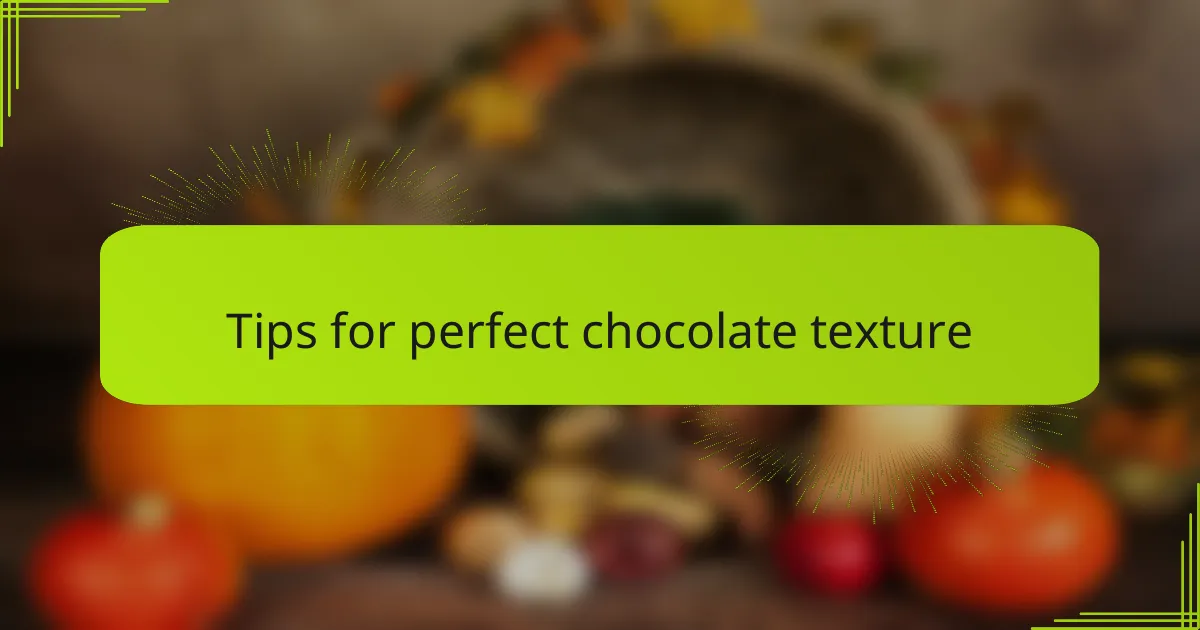
Tips for perfect chocolate texture
Getting the perfect chocolate texture really comes down to temperature control. I learned quickly that even a difference of a degree or two can change everything—from that silky smoothness to a chalky finish. Have you ever noticed how chocolate can sometimes look wonderful but feel grainy in your mouth? That’s usually a sign the tempering missed the mark.
Another tip I swear by is stirring continuously but gently. At first, I thought vigorous stirring would speed things up, but it actually introduced air bubbles that ruined the texture. Slow, patient movements help the chocolate crystals form evenly, giving you that satisfying snap every time. Isn’t it funny how treating chocolate like a delicate friend makes all the difference?
Finally, don’t underestimate the benefits of letting your chocolate rest once it’s tempered. I used to unwrap treats too soon and was disappointed by soft centers. Waiting just a bit longer lets the texture set perfectly and enhances the overall mouthfeel. Have you ever tried that extra moment of patience? It feels like magic when the chocolate responds.
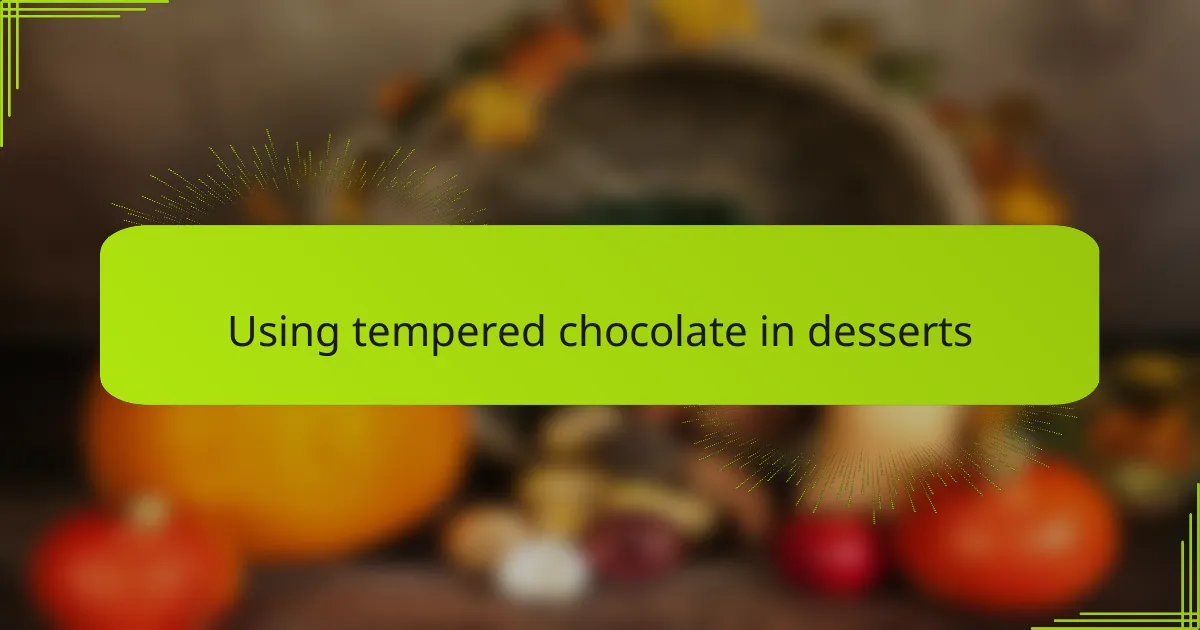
Using tempered chocolate in desserts
Using tempered chocolate in desserts completely elevates their look and feel. I remember the first time I spread tempered chocolate over a cake—its glossy sheen instantly made the whole dessert look professional. That crisp snap when you bite into it adds such a satisfying contrast to soft fillings or fluffy textures.
I’ve also found that tempered chocolate holds up better when decorating. Once, I was making chocolate shards for a mousse and noticed how they stayed firm and shiny for days, unlike when I used untempered chocolate that melted and dulled quickly. Have you ever struggled with decorations that just won’t stay put? Tempered chocolate is the answer.
Beyond aesthetics, tempered chocolate can transform the eating experience itself. When I use it as a coating on truffles or dipped fruits, the chocolate shell cracks beautifully, releasing rich flavor bursts inside. Isn’t it amazing how a simple technique can create such a memorable texture?




